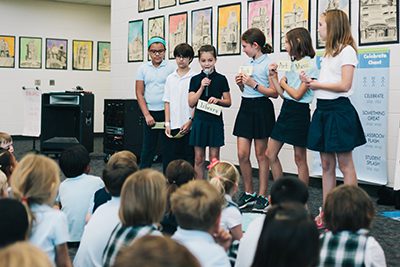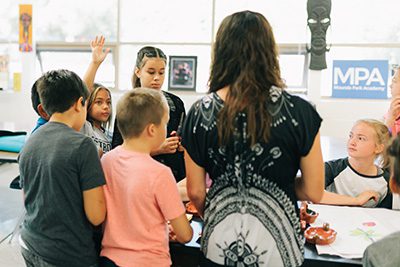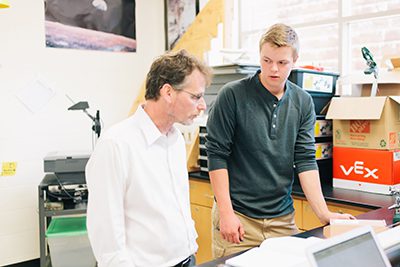March 4, 2019
 What does the term “student voice” mean today? Internationally recognized expert in youth voice and student engagement, Adam Fletcher relates that it goes far beyond the important work of helping students develop their own voices. The concept now implies a much deeper commitment, suggesting that educators have an ethical imperative to engage students in new ways that are vital to school improvement. With student voice integrated into the core values at MPA, even our youngest children help to significantly impact their educational environments and experiences.
What does the term “student voice” mean today? Internationally recognized expert in youth voice and student engagement, Adam Fletcher relates that it goes far beyond the important work of helping students develop their own voices. The concept now implies a much deeper commitment, suggesting that educators have an ethical imperative to engage students in new ways that are vital to school improvement. With student voice integrated into the core values at MPA, even our youngest children help to significantly impact their educational environments and experiences.
MPA’s PreK teacher Debbie LaChapelle describes how her small but mighty students shape their education. One four-year-old girl, for example, requested a PreK art show like the older children have. LaChapelle picked up on the idea, credited the student with it, and shifted her curriculum to include an annual art exhibit. “I witness in my students pride, confidence, respect for themselves and others, empathy, and leadership,” she shares. “When their ideas and thoughts are accepted and validated, it illustrates to them that they matter and can make a difference.”
Kari O’Keefe provides another example of how first graders design their educational environment. “From the moment you walk into the classroom, one sees that the room belongs to the students. They have created everything from the alphabet and number line to the bulletin boards and borders. They came up with classroom expectations and labeled special areas of the space. They have a true sense of ownership as they’ve helped to create every aspect of their classroom.”
 As students move into Middle School, it is vitally important to continue engaging them in their own education, recognizing that they have developed stronger ways to express themselves. However, MPA students learn that as they develop their own identities, they must also practice empathy for others. That same empathy serves as the essence for their own voices to emerge, according to Ann Devout Atchison, Middle School English teacher. She shares, “My job is to facilitate curricular choices that not only teach students to read, write, think, speak, and listen with increasing clarity and artistry, but to create security, adventure, and thirst so that seventh and eighth grade voices will not only be uniquely empowered and realized, but heard and understood.”
As students move into Middle School, it is vitally important to continue engaging them in their own education, recognizing that they have developed stronger ways to express themselves. However, MPA students learn that as they develop their own identities, they must also practice empathy for others. That same empathy serves as the essence for their own voices to emerge, according to Ann Devout Atchison, Middle School English teacher. She shares, “My job is to facilitate curricular choices that not only teach students to read, write, think, speak, and listen with increasing clarity and artistry, but to create security, adventure, and thirst so that seventh and eighth grade voices will not only be uniquely empowered and realized, but heard and understood.”
One might wonder how MPA teachers bring student voice into more structured subject areas such as math and science, where concepts are based on proofs and laws. It’s obviously a balancing act. Even here, there’s room for creativity in educating and inspiring learners, and part of the teacher’s role is to guide students to be self-reflective.
Middle School science teacher Courtney Nagle relates how being an educator at MPA “gives me the freedom to be creative and promote creative assignments.” She cites examples such as a sixth grade assignment to create their own insect and the fifth grade inventor’s fair. The tradition of SEEK projects also allows students a great deal of freedom to study virtually anything related to science. Children’s ability to identify and follow areas of personal interest reinforces what our educators know—that human beings are more likely to learn best when the motivation is intrinsic rather than extrinsic.
As a Middle School math teacher, Chris Peterson expands on that idea, “Kids care more about learning and retain the information better when they are more engaged with their learning. Students also seem to enjoy class more if they are fully focused on the topic.” It makes sense, but as an instructor, this requires stepping away from the traditional top-down approach to education.
 As students progress to Upper School and topics become even more rigorous, the core concept of student voice stays intact. Many alumni, for example, fondly recall the impact of Upper School physics teacher Marc Shapiro’s bridge-building project, which gives an embodied and real-world understanding of physics. Shapiro says, “In the end, I don’t want a student to maintain a ‘unique perspective’ that is contrary to the laws of physics. Rather, I want them to recognize their own perspective, compare it to how they have found that nature actually works in our class investigations, and adjust their understanding as necessary.”
As students progress to Upper School and topics become even more rigorous, the core concept of student voice stays intact. Many alumni, for example, fondly recall the impact of Upper School physics teacher Marc Shapiro’s bridge-building project, which gives an embodied and real-world understanding of physics. Shapiro says, “In the end, I don’t want a student to maintain a ‘unique perspective’ that is contrary to the laws of physics. Rather, I want them to recognize their own perspective, compare it to how they have found that nature actually works in our class investigations, and adjust their understanding as necessary.”
Hannah Sullivan, Upper School science teacher, appreciates the challenge of leaning into the concept. She actively seeks opportunities to follow her students’ interests, offering an example from her environmental science course, where their questions about gall formations on campus plants led
to a multi-year study. “What started as a last-minute lab to let students answer their own question of ‘what’s inside a gall?’ turned into a complex investigation into parasitism and predation,” Sullivan reflects. “My colleagues and I allow students to engage more fully in issues that we—as a global community—will need their knowledge and passion to solve, such as climate change. In order to have real impact on students and the environment, it has to be something that they are excited to engage with, rather than a requirement. We can start them on this while they are still at MPA.”
In the fine arts, where self-expression is already highly encouraged, students are given a great deal of freedom to shape their learning experiences as individuals and as groups. Middle and Upper School art teacher Renee Sonka provides an example. “Each year, I have fifth grade students think about what artistic advice they would give others. We call this collection of comments our ‘Art Manifesto.’ Initially, their ideas are somewhat obvious, but a good teacher’s role is to guide them through a process that helps them tap into their creativity and articulate fresh ideas in their own voice, making room to think beyond typical boundaries. We end this exercise with a beautiful variety of thoughts including: admire your work, be positive, take your time, try new things, be humble, be active, make it count, be grateful, be confident, get outside, vote, don’t settle, and more.”
Student voice does not look the same for everyone. Sonka recalls, “While it is fulfilling to witness all students develop their artistic voice, it is particularly moving as a teacher to see a strong visual voice emerge from someone who is quiet, verbally. One student in particular who comes to mind, was quiet in class and at home, but went on to pursue art school in New York. As a senior, she’d developed a body of work that was conceptually and visually complex, weaving together strong statements about education, the economy, healthcare, human rights, energy, the environment, the arts, and even the college admissions process. When her parents saw the depth and breadth of her visual thought, they said, ‘Whoa, she’s no wallflower!’ All students transform when they find their authentic voice, and educating the whole child means we recognize that some students are stronger communicators in languages that are non-verbal—in this case, visual.”
Because of the students’ voices, MPA has pushed itself to innovate. They will continue to show us what’s new, what’s needed, and what they’ll use in their education far into the future.
Mounds Park Academy, a PreK-12 private school in Saint Paul, is currently accepting applications for the 2019-20 school year. For more information about admission and to schedule your tour, visit moundsparkacademy.org/admission. We look forward to getting to know your family!